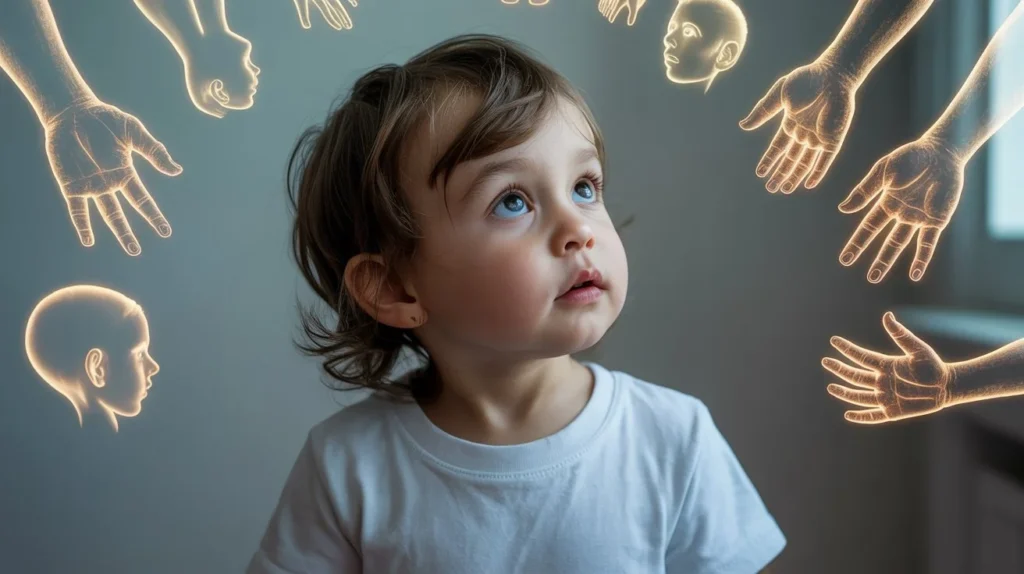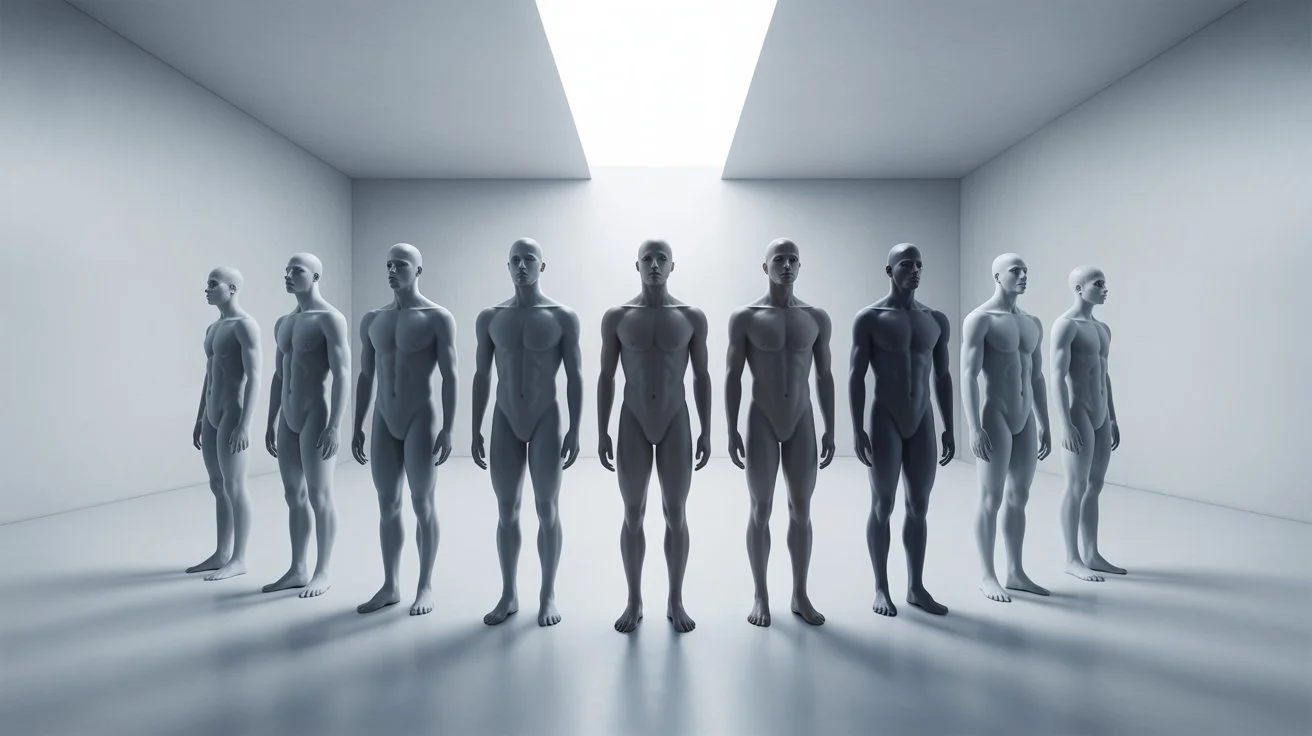Have you ever wondered why humans have two eyes, two arms, two legs, and one head? Or why our faces look so different from one another, yet so similar to other primates? The way we look isn’t random—it’s the result of millions of years of evolution, shaped by biology, natural selection, genetics, and the environments our ancestors lived in. Let’s dive into the science behind our physical features and explore why humans look the way we do, with a few comparisons to our animal cousins along the way.
The Blueprint of Bilateral Symmetry
Let’s start with the basics: why do we have two eyes, two ears, two arms, and two legs? This is because humans, like most animals, follow a body plan called bilateral symmetry. This means our bodies are roughly mirror images along a central axis—if you draw a line down the middle of a human, the left and right sides are similar. This design goes way back to our ancient ancestors, worm-like creatures that swam in prehistoric oceans over 500 million years ago, as explored in research on early bilaterian evolution.
Bilateral symmetry is a winner in evolution because it helps animals move efficiently. Having two sides with matching limbs allows for balanced movement, whether crawling, swimming, or walking. Compare this to jellyfish, which have radial symmetry (like a wheel) and drift aimlessly. Our two legs let us walk upright, freeing our two arms for tasks like tool-making or throwing. Even our two eyes and ears work together to give us depth perception and directional hearing—crucial for spotting predators or prey.
Why not three arms or four legs? Evolution tends to stick with what works. Adding extra limbs might cost more energy or complicate coordination without clear benefits. For example, insects have six legs for stability on uneven surfaces, but humans evolved to walk on two legs, which is more energy-efficient for covering long distances, like our ancestors did on the African savanna.

Why One Head?
Our single head is another evolutionary feature. The head houses our brain, eyes, ears, nose, and mouth—all critical for sensing and interacting with the world. Centralizing these organs in one place makes sense: it’s like having a control tower for the body. Animals like octopuses have more distributed nervous systems, with “mini-brains” in their arms, but for land-dwelling vertebrates like us, a single head is efficient. It keeps the brain close to sensory organs, speeding up reactions, as discussed in studies on vertebrate cranial evolution.
The head’s position at the top of the body also gives us a survival edge. It’s elevated, so we can see farther, hear better, and breathe without choking on dust or water. Imagine if our head were lower, like a crocodile’s—it’d be harder to spot danger while walking upright.
The Story of Our Faces
Our faces are uniquely human, but they’re also a product of evolution. Why do we have two eyes in the front of our face? This is called binocular vision, and it’s a trait we share with predators like cats and owls. Having both eyes facing forward gives us depth perception, which is vital for tasks like hunting, climbing trees, or threading a needle. Compare this to prey animals like deer, whose eyes are on the sides of their heads for a wider field of view to spot danger.
Our noses and mouths are shaped by survival needs too. The nose filters air and warms it before it hits our lungs, which was especially important for our ancestors in cold or dry climates. The mouth, with its teeth and tongue, is designed for eating a varied diet—meat, plants, and nuts—unlike specialized mouths, like a cow’s for grazing or a mosquito’s for piercing.
But why do human faces vary so much? Genetics plays a big role. Your facial features—eye shape, nose size, jawline—are influenced by your DNA, which comes from your parents and their ancestors. Over time, human populations spread across the globe, and small genetic changes accumulated due to natural selection and genetic drift. For example, people in colder climates, like northern Europe, often have narrower noses to warm air better, while those in warmer climates, like parts of Africa, may have wider noses for cooling. These are adaptations to local environments, as shown in research on craniofacial variation.
Facial variation also has a social purpose. Humans are highly social, and recognizing individuals is key to cooperation and survival. Unique facial features, shaped by genetics, help us tell one person from another, just like zebras use their stripes for identification. Sexual selection—choosing mates based on attractive traits—also shapes faces. Symmetrical faces, for instance, are often seen as more attractive because symmetry signals good health and strong genes.
Walking Upright: The Two-Leg Revolution
One of the most defining human traits is bipedalism—walking on two legs. Our ancestors started walking upright around 6 million years ago, likely to see over tall grasses, carry food, or save energy while traveling. This shift reshaped our bodies. Our spine curved into an S-shape to support an upright posture, and our pelvis widened to balance our weight. Compare this to chimpanzees, our closest relatives, who knuckle-walk on all fours and have straighter spines. Studies on bipedalism highlight its role in human evolution.
Bipedalism freed our hands, leading to tool use, which sparked brain growth and cultural development. But it came with trade-offs. Two legs are less stable than four, and our narrow pelvis makes childbirth riskier compared to other mammals. Still, the advantages—mobility, dexterity, and brainpower—made bipedalism a game-changer.
Skin, Hair, and Sweat
Our skin and hair tell another evolutionary story. Unlike furry mammals like bears, humans have sparse body hair but can grow long head hair. Why? As our ancestors moved from forests to open savannas, they needed to stay cool. Less body hair and sweat glands (unique among primates) helped us regulate body temperature during long hunts or walks under the sun. Head hair, though, likely protected our scalps from harsh sunlight.
Skin color is another adaptation. Darker skin, rich in melanin, protects against UV radiation in sunny regions, like sub-Saharan Africa. Lighter skin evolved in low-sunlight areas, like northern Europe, to absorb more vitamin D from limited sunlight. These differences show how humans adapted to diverse environments over thousands of years, as detailed in research on skin pigmentation.
Comparing Humans to Other Animals
Looking at other animals helps us understand our form. Birds have wings for flight, but our arms are built for precision, not speed. Dolphins have flippers for swimming, while our legs are optimized for land. Even among primates, humans stand out. Gorillas have massive jaws for chewing tough plants, but our smaller jaws and teeth suit a mixed diet. Our large brains, about three times bigger than a chimp’s, drive our intelligence, language, and culture—traits that set us apart.
Reflection: Thriving in Our Human Form
So, why do humans look the way we do? Our bodies are a masterpiece of evolution, sculpted by natural selection to survive and thrive. Two eyes give us depth perception, two legs free our hands for creativity, and one head centralizes our senses. Our varied faces reflect genetic diversity and environmental adaptations, while our upright posture and big brains unlock endless possibilities. Every feature, from our sweat glands to our skin tones, tells a story of survival.
Our form isn’t perfect, back pain and childbirth risks remind us of evolution’s trade-offs, but it’s remarkably suited to Earth’s challenges. We’ve used our bodies to build tools, create art, explore continents, and even reach the stars. As we reflect on our physical design, it’s a reminder of our shared history with all life on Earth and our unique ability to shape the future. So, the next time you look in the mirror, see not just a face, but a 4-billion-year journey of life adapting to the world.
